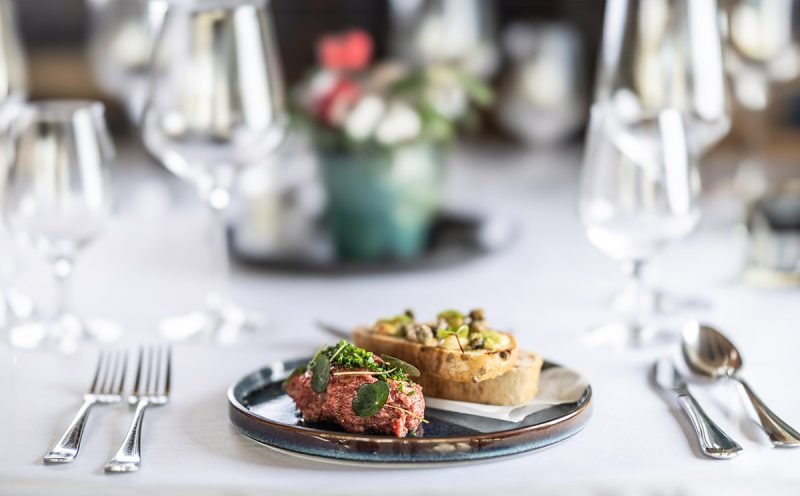There has been a remarkable evolution of fine dining over the decades, moving from the rigid formality of French haute cuisine to a diverse landscape of culinary experiences that prioritize innovation, sustainability, and accessibility. This transformation reflects broader cultural shifts, technological advancements, and changing consumer preferences, creating a dining landscape that is more dynamic and inclusive than ever before.
The Classical Era: French Dominance
For much of the 20th century, fine dining was synonymous with French cuisine and its rigid hierarchies. Auguste Escoffier’s brigade system dominated professional kitchens, while restaurants adhered to strict protocols of white tablecloths, formal service, and wine-focused beverage programs. Success was measured by Michelin stars and formal recognition, with diners expected to conform to established etiquette.
This era established important culinary techniques and traditions but was often exclusionary—both financially and culturally. The dining experience was reverent, sometimes intimidating, and focused primarily on the food rather than the holistic experience.


Farm-to-Table Revolution
The 1970s saw the emergence of a new culinary philosophy pioneered by Alice Waters at Chez Panisse in Berkeley, California. This farm-to-table approach emphasized seasonal, locally-sourced ingredients and transparent supply chains. Chefs began building direct relationships with farmers, fishermen, and foragers, highlighting the provenance of ingredients on their menus.
This movement represented a fundamental shift in values – from technical perfection to ingredient quality and ethical sourcing. It connected dining to place and season, creating a more authentic and environmentally conscious approach to gastronomy that continues to influence restaurants worldwide. If you’re visiting Los Cabos, check out Tamarindos for great Mexican farm to table dining.


Democratization and Concept Dining
Perhaps one of the most significant trends in recent years has been the democratization of fine dining experiences, exemplified by concepts like Six by Nico. Founded by Scottish-Italian chef Nico Simeone, this innovative restaurant chain has reimagined accessibility in the fine dining space.
Six by Nico offers six-course tasting menus that change every six weeks, each built around a different theme – from “The Chippie” (elevated takes on British fish and chip shop classics) to “An Italian Road Trip.” By pricing these experiences at a relatively affordable level (typically around £50 per person without drinks), Six by Nico has made tasting menus accessible to a broader audience while maintaining culinary creativity and quality.
This concept dining approach, offering highly curated experiences at accessible price points, has helped bridge the gap between casual and fine dining. It enables more diners to experience carefully crafted tasting menus without exclusionary prices or dress codes.


Sustainability and Zero Waste
Environmental consciousness has become central to modern fine dining, with sustainability extending beyond ingredient sourcing to encompass every aspect of restaurant operations. Pioneering establishments like Silo London (the world’s first zero-waste restaurant) have demonstrated that fine dining can operate with minimal environmental impact.
Today’s sustainability-focused restaurants employ practices such as:
- Whole-ingredient utilization, with creative uses for traditionally discarded items
- Composting systems that convert food waste into growing material
- Energy-efficient equipment and renewable energy sources
- Elimination of single-use plastics and unnecessary packaging
- Water conservation and recycling systems
Chefs like Dan Barber at Blue Hill at Stone Barns in the United States have taken this philosophy further, creating agricultural centers where dining, farming, and education intersect, demonstrating a holistic approach to sustainable gastronomy.


Beyond Wine: The New Pairing Revolution
While wine has traditionally dominated fine dining beverage programs, innovative restaurants now offer diverse pairing options to complement their cuisine. These include:
- Craft cocktail pairings tailored to specific dishes
- Non-alcoholic “mocktail” pairings for non-drinkers
- House-made fermented beverages like kombucha or kefir
- Artisanal tea programs with rare or custom-blended varieties
- Regional beverage specialties that connect to the restaurant’s culinary perspective
Establishments like Alinea in Chicago have pioneered these alternative pairings, recognizing that many diners either can’t or choose not to consume alcohol but still desire thoughtfully paired beverages that enhance their meal.


Immersive Dining Experiences
Modern fine dining increasingly emphasizes multisensory engagement, transforming meals into theatrical experiences. Restaurants such as Ultraviolet in Shanghai and Sublimotion in Ibiza use projection mapping, custom soundscapes, and dramatic presentation to create immersive environments where each course exists within a carefully orchestrated sensory landscape.
Even less technologically elaborate establishments now consider lighting, music, aroma, and tactile elements as essential components of the dining experience. This approach acknowledges that memorable dining experiences engage all senses, not just taste.


Health-Conscious Innovation
Contemporary fine dining has embraced nutritional awareness without sacrificing flavor or creativity. Innovative chefs are:
- Experimenting with natural sugar alternatives like monk fruit, date syrup, and coconut sugar
- Incorporating functional ingredients with potential health benefits
- Reducing refined carbohydrates and unhealthy fats
- Creating indulgent-tasting dishes with healthier preparation methods
- Catering to specific dietary needs with the same attention to detail as standard menu items
Rather than treating health-focused dishes as limited alternatives, forward-thinking restaurants integrate nutritional considerations into their core culinary approach, recognizing that wellness and gastronomy can complement rather than contradict each other.


Unexpected Flavor Combinations or Ingredients
The element of surprise has become central to contemporary fine dining, with chefs deliberately subverting expectations through unusual ingredient pairings and preparation techniques. Establishments like Noma in Copenhagen have famously served dishes featuring ingredients like live ants, fermented grasshoppers, and reindeer moss, challenging diners’ preconceptions about edibility and flavor.
Less extreme examples include combining seemingly disparate cultural influences, pairing traditionally savory ingredients in desserts, or applying advanced techniques to humble ingredients. This approach keeps dining experiences novel and engaging, encouraging conversations about flavor, tradition, and culinary boundaries.


Elevated Comfort Food
In a reaction against overly intellectual or precious cuisine, many fine dining establishments have embraced refined versions of nostalgic comfort foods. This trend acknowledges the emotional connection diners have with familiar dishes while applying sophisticated techniques and exceptional ingredients to these classics.
Examples include David Chang’s Momofuku empire, which elevated humble ramen to fine dining status, and restaurants like The French Laundry, which might serve an exquisite version of macaroni and cheese or a refined take on fried chicken.
This approach balances innovation with familiarity, creating dishes that resonate emotionally while showcasing technical prowess.
According to a report by Tastewise, interest in food focused on togetherness has grown by 46% YoY. There has been a 15% YoY increase in discussions about sharing platters.


Plant-Based Revolution
Perhaps no trend has more fundamentally challenged fine dining conventions than the rise of plant-based cuisine. No longer relegated to specialized vegan establishments, sophisticated plant-based dishes now feature prominently on menus at the world’s most acclaimed restaurants.
Chefs like Daniel Humm at Eleven Madison Park in New York (which transitioned to an entirely plant-based menu in 2021) have demonstrated that vegetables, fruits, fungi, and legumes can create dining experiences every bit as luxurious and satisfying as those centered around animal products. Tian Bistro in Vienna is another great plant-based option.
This shift reflects growing environmental consciousness, ethical considerations, and recognition of the culinary possibilities inherent in plant ingredients.


Digital Integration
Technology has transformed the dining experience beyond the kitchen, with digital innovation enhancing customer interaction at every touchpoint. QR code menus – accelerated by the pandemic – allow for real-time menu updates and multimedia content about dishes, ingredients, and preparation techniques. They’re not always popular with diners, so restaurants should consider having a traditional printed option 😉
Advanced reservation systems provide personalized experiences based on diner preferences and history, while integrated payment systems streamline the traditionally awkward process of settling the bill. Social media integration has also become crucial, with restaurants designing spaces and dishes with “shareability” in mind, recognizing that diner documentation has become an expected part of the experience.


The Future of Fine Dining
As fine dining continues to evolve, several emerging trends suggest its future direction:
- Hyper-regionalism, with restaurants focusing on micro-local ingredients and traditions
- Biodiverse menus featuring overlooked or underutilized ingredients to promote ecological resilience
- Integration of augmented reality to enhance the storytelling aspects of dining
- Personalization based on individual taste preferences and nutritional needs
- Further democratization through accessible pricing models and casual environments
What remains consistent throughout this evolution is the emphasis on creating meaningful experiences that engage diners intellectually, emotionally, and sensually. The white tablecloths and formal protocols may have largely disappeared, but the commitment to excellence, creativity, and hospitality that defines true fine dining endures in more diverse and accessible forms.
As these innovative concepts have demonstrated, the future of fine dining lies not in rigid tradition but in creating memorable, thoughtful experiences that connect diners to culinary creativity.
Follow us for more luxury trends and tips















Leave a Reply